Comprehensive Analysis of Cost and Control in Management Accounting
VerifiedAdded on 2023/06/14
|16
|3200
|184
Homework Assignment
AI Summary
This assignment solution delves into various aspects of management accounting for cost and control. It begins by explaining Michel Foucault's theory of Panopticism and its application in preventing corruption through strong auditing programs and transparency. The functions of management accounting, including planning, organizing, and decision-making, are discussed in detail. The assignment highlights the use of checklists for maintaining consistency and control, using the rock band Van Halen as an example. It provides a comprehensive manufacturing statement and income statement for Tendulkar Manufacturing Co., both in normal and formula views. Further, it explains the perpetual inventory system and the accounting treatment of overtime payments. Journal entries for material control and accrued payroll are presented, along with a detailed analysis of accrued payroll and related journal entries. Finally, the document differentiates between activity-based costing (ABC) and traditional costing methods, emphasizing the accuracy of ABC costing. Desklib offers a wide array of similar solved assignments and study resources for students.
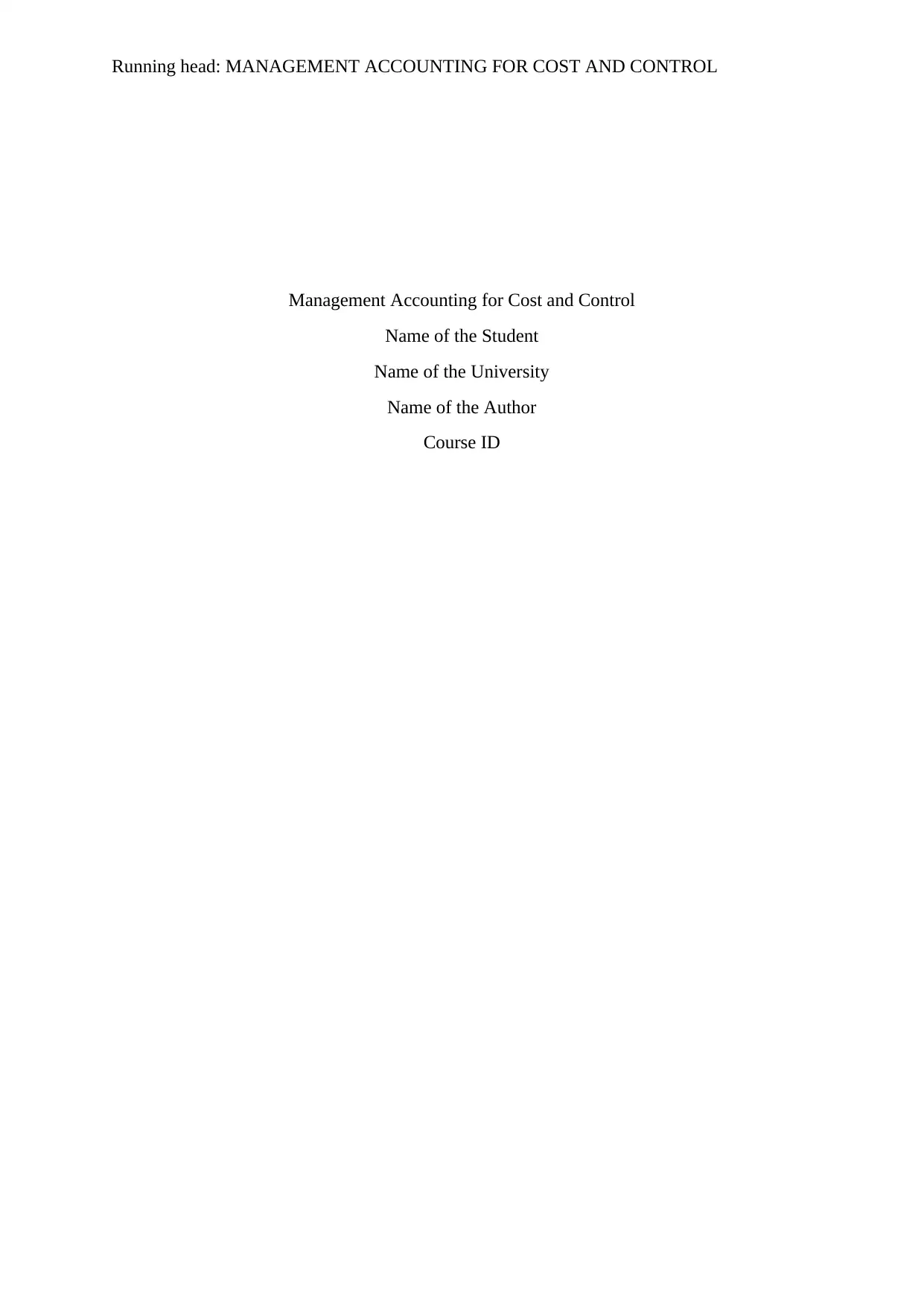
Running head: MANAGEMENT ACCOUNTING FOR COST AND CONTROL
Management Accounting for Cost and Control
Name of the Student
Name of the University
Name of the Author
Course ID
Management Accounting for Cost and Control
Name of the Student
Name of the University
Name of the Author
Course ID
Paraphrase This Document
Need a fresh take? Get an instant paraphrase of this document with our AI Paraphraser
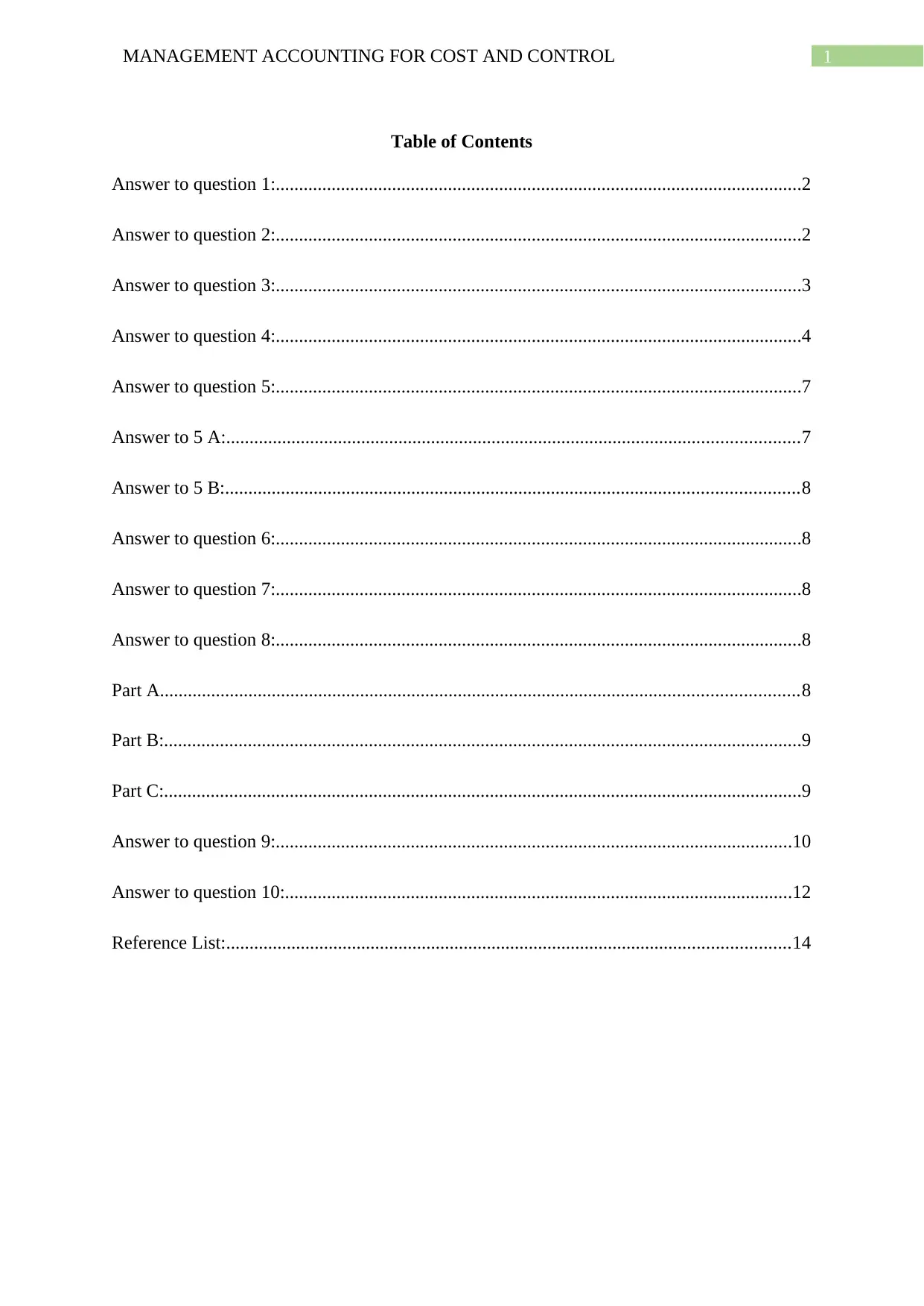
1MANAGEMENT ACCOUNTING FOR COST AND CONTROL
Table of Contents
Answer to question 1:.................................................................................................................2
Answer to question 2:.................................................................................................................2
Answer to question 3:.................................................................................................................3
Answer to question 4:.................................................................................................................4
Answer to question 5:.................................................................................................................7
Answer to 5 A:...........................................................................................................................7
Answer to 5 B:...........................................................................................................................8
Answer to question 6:.................................................................................................................8
Answer to question 7:.................................................................................................................8
Answer to question 8:.................................................................................................................8
Part A.........................................................................................................................................8
Part B:.........................................................................................................................................9
Part C:.........................................................................................................................................9
Answer to question 9:...............................................................................................................10
Answer to question 10:.............................................................................................................12
Reference List:.........................................................................................................................14
Table of Contents
Answer to question 1:.................................................................................................................2
Answer to question 2:.................................................................................................................2
Answer to question 3:.................................................................................................................3
Answer to question 4:.................................................................................................................4
Answer to question 5:.................................................................................................................7
Answer to 5 A:...........................................................................................................................7
Answer to 5 B:...........................................................................................................................8
Answer to question 6:.................................................................................................................8
Answer to question 7:.................................................................................................................8
Answer to question 8:.................................................................................................................8
Part A.........................................................................................................................................8
Part B:.........................................................................................................................................9
Part C:.........................................................................................................................................9
Answer to question 9:...............................................................................................................10
Answer to question 10:.............................................................................................................12
Reference List:.........................................................................................................................14
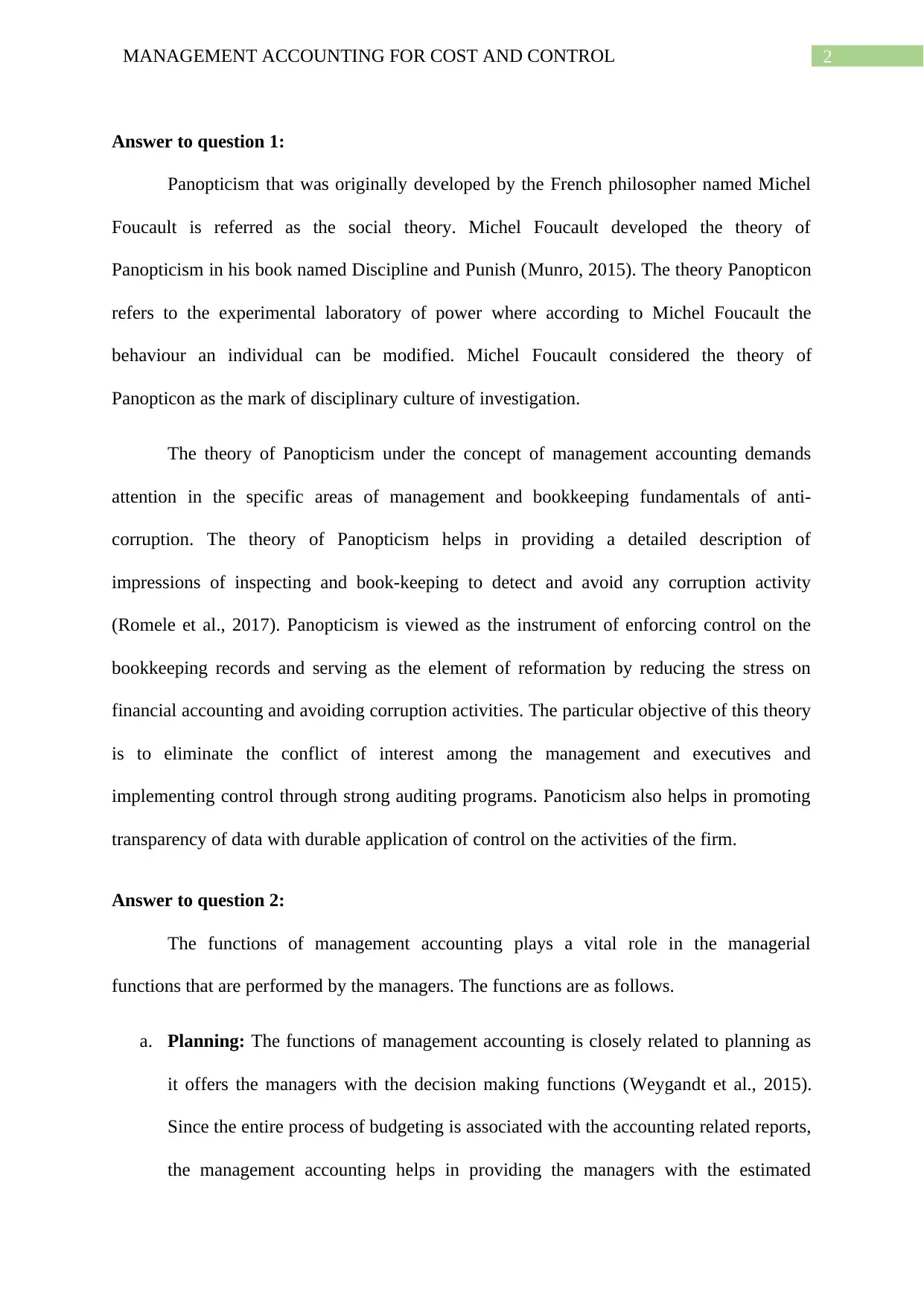
2MANAGEMENT ACCOUNTING FOR COST AND CONTROL
Answer to question 1:
Panopticism that was originally developed by the French philosopher named Michel
Foucault is referred as the social theory. Michel Foucault developed the theory of
Panopticism in his book named Discipline and Punish (Munro, 2015). The theory Panopticon
refers to the experimental laboratory of power where according to Michel Foucault the
behaviour an individual can be modified. Michel Foucault considered the theory of
Panopticon as the mark of disciplinary culture of investigation.
The theory of Panopticism under the concept of management accounting demands
attention in the specific areas of management and bookkeeping fundamentals of anti-
corruption. The theory of Panopticism helps in providing a detailed description of
impressions of inspecting and book-keeping to detect and avoid any corruption activity
(Romele et al., 2017). Panopticism is viewed as the instrument of enforcing control on the
bookkeeping records and serving as the element of reformation by reducing the stress on
financial accounting and avoiding corruption activities. The particular objective of this theory
is to eliminate the conflict of interest among the management and executives and
implementing control through strong auditing programs. Panoticism also helps in promoting
transparency of data with durable application of control on the activities of the firm.
Answer to question 2:
The functions of management accounting plays a vital role in the managerial
functions that are performed by the managers. The functions are as follows.
a. Planning: The functions of management accounting is closely related to planning as
it offers the managers with the decision making functions (Weygandt et al., 2015).
Since the entire process of budgeting is associated with the accounting related reports,
the management accounting helps in providing the managers with the estimated
Answer to question 1:
Panopticism that was originally developed by the French philosopher named Michel
Foucault is referred as the social theory. Michel Foucault developed the theory of
Panopticism in his book named Discipline and Punish (Munro, 2015). The theory Panopticon
refers to the experimental laboratory of power where according to Michel Foucault the
behaviour an individual can be modified. Michel Foucault considered the theory of
Panopticon as the mark of disciplinary culture of investigation.
The theory of Panopticism under the concept of management accounting demands
attention in the specific areas of management and bookkeeping fundamentals of anti-
corruption. The theory of Panopticism helps in providing a detailed description of
impressions of inspecting and book-keeping to detect and avoid any corruption activity
(Romele et al., 2017). Panopticism is viewed as the instrument of enforcing control on the
bookkeeping records and serving as the element of reformation by reducing the stress on
financial accounting and avoiding corruption activities. The particular objective of this theory
is to eliminate the conflict of interest among the management and executives and
implementing control through strong auditing programs. Panoticism also helps in promoting
transparency of data with durable application of control on the activities of the firm.
Answer to question 2:
The functions of management accounting plays a vital role in the managerial
functions that are performed by the managers. The functions are as follows.
a. Planning: The functions of management accounting is closely related to planning as
it offers the managers with the decision making functions (Weygandt et al., 2015).
Since the entire process of budgeting is associated with the accounting related reports,
the management accounting helps in providing the managers with the estimated
⊘ This is a preview!⊘
Do you want full access?
Subscribe today to unlock all pages.

Trusted by 1+ million students worldwide
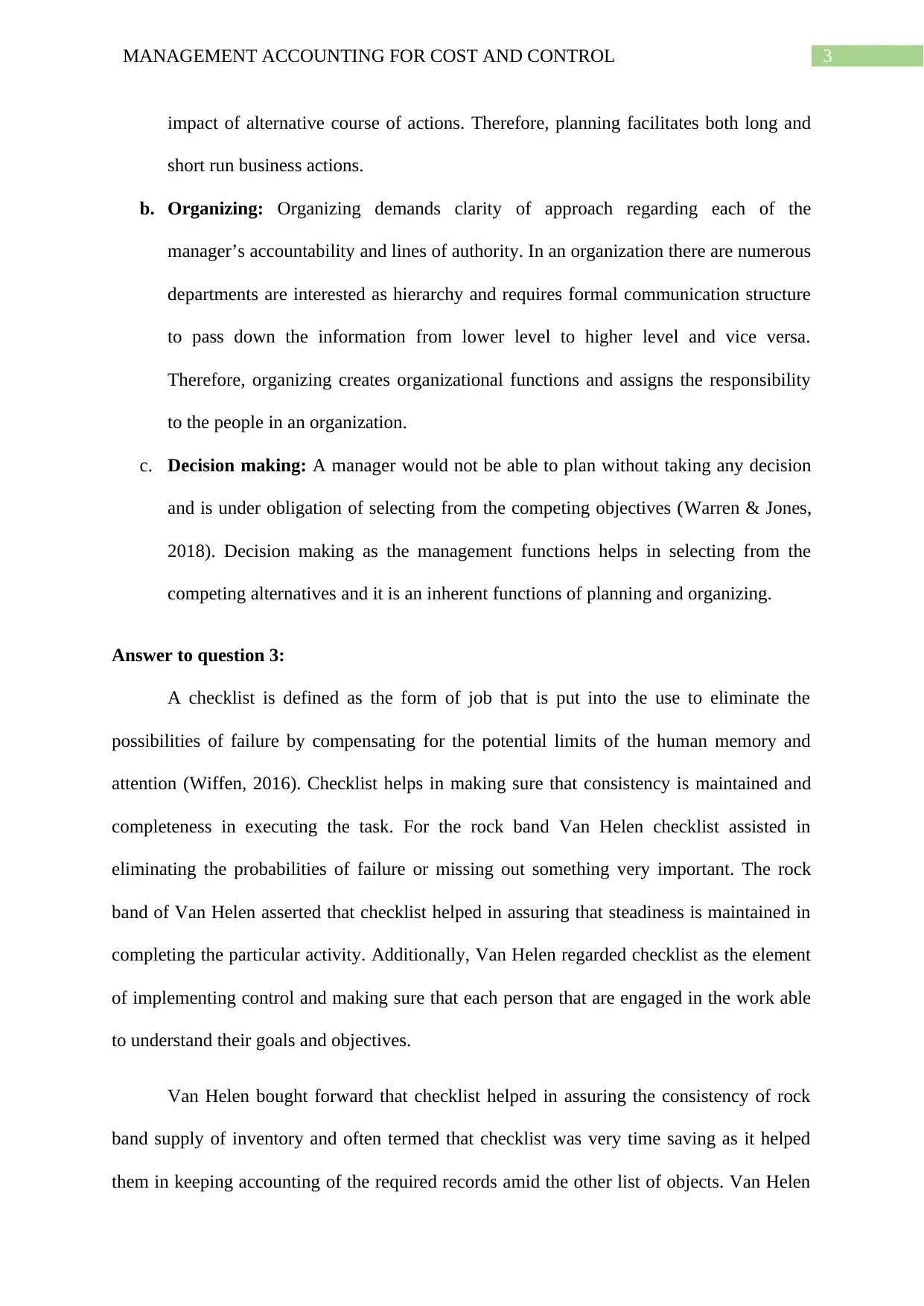
3MANAGEMENT ACCOUNTING FOR COST AND CONTROL
impact of alternative course of actions. Therefore, planning facilitates both long and
short run business actions.
b. Organizing: Organizing demands clarity of approach regarding each of the
manager’s accountability and lines of authority. In an organization there are numerous
departments are interested as hierarchy and requires formal communication structure
to pass down the information from lower level to higher level and vice versa.
Therefore, organizing creates organizational functions and assigns the responsibility
to the people in an organization.
c. Decision making: A manager would not be able to plan without taking any decision
and is under obligation of selecting from the competing objectives (Warren & Jones,
2018). Decision making as the management functions helps in selecting from the
competing alternatives and it is an inherent functions of planning and organizing.
Answer to question 3:
A checklist is defined as the form of job that is put into the use to eliminate the
possibilities of failure by compensating for the potential limits of the human memory and
attention (Wiffen, 2016). Checklist helps in making sure that consistency is maintained and
completeness in executing the task. For the rock band Van Helen checklist assisted in
eliminating the probabilities of failure or missing out something very important. The rock
band of Van Helen asserted that checklist helped in assuring that steadiness is maintained in
completing the particular activity. Additionally, Van Helen regarded checklist as the element
of implementing control and making sure that each person that are engaged in the work able
to understand their goals and objectives.
Van Helen bought forward that checklist helped in assuring the consistency of rock
band supply of inventory and often termed that checklist was very time saving as it helped
them in keeping accounting of the required records amid the other list of objects. Van Helen
impact of alternative course of actions. Therefore, planning facilitates both long and
short run business actions.
b. Organizing: Organizing demands clarity of approach regarding each of the
manager’s accountability and lines of authority. In an organization there are numerous
departments are interested as hierarchy and requires formal communication structure
to pass down the information from lower level to higher level and vice versa.
Therefore, organizing creates organizational functions and assigns the responsibility
to the people in an organization.
c. Decision making: A manager would not be able to plan without taking any decision
and is under obligation of selecting from the competing objectives (Warren & Jones,
2018). Decision making as the management functions helps in selecting from the
competing alternatives and it is an inherent functions of planning and organizing.
Answer to question 3:
A checklist is defined as the form of job that is put into the use to eliminate the
possibilities of failure by compensating for the potential limits of the human memory and
attention (Wiffen, 2016). Checklist helps in making sure that consistency is maintained and
completeness in executing the task. For the rock band Van Helen checklist assisted in
eliminating the probabilities of failure or missing out something very important. The rock
band of Van Helen asserted that checklist helped in assuring that steadiness is maintained in
completing the particular activity. Additionally, Van Helen regarded checklist as the element
of implementing control and making sure that each person that are engaged in the work able
to understand their goals and objectives.
Van Helen bought forward that checklist helped in assuring the consistency of rock
band supply of inventory and often termed that checklist was very time saving as it helped
them in keeping accounting of the required records amid the other list of objects. Van Helen
Paraphrase This Document
Need a fresh take? Get an instant paraphrase of this document with our AI Paraphraser
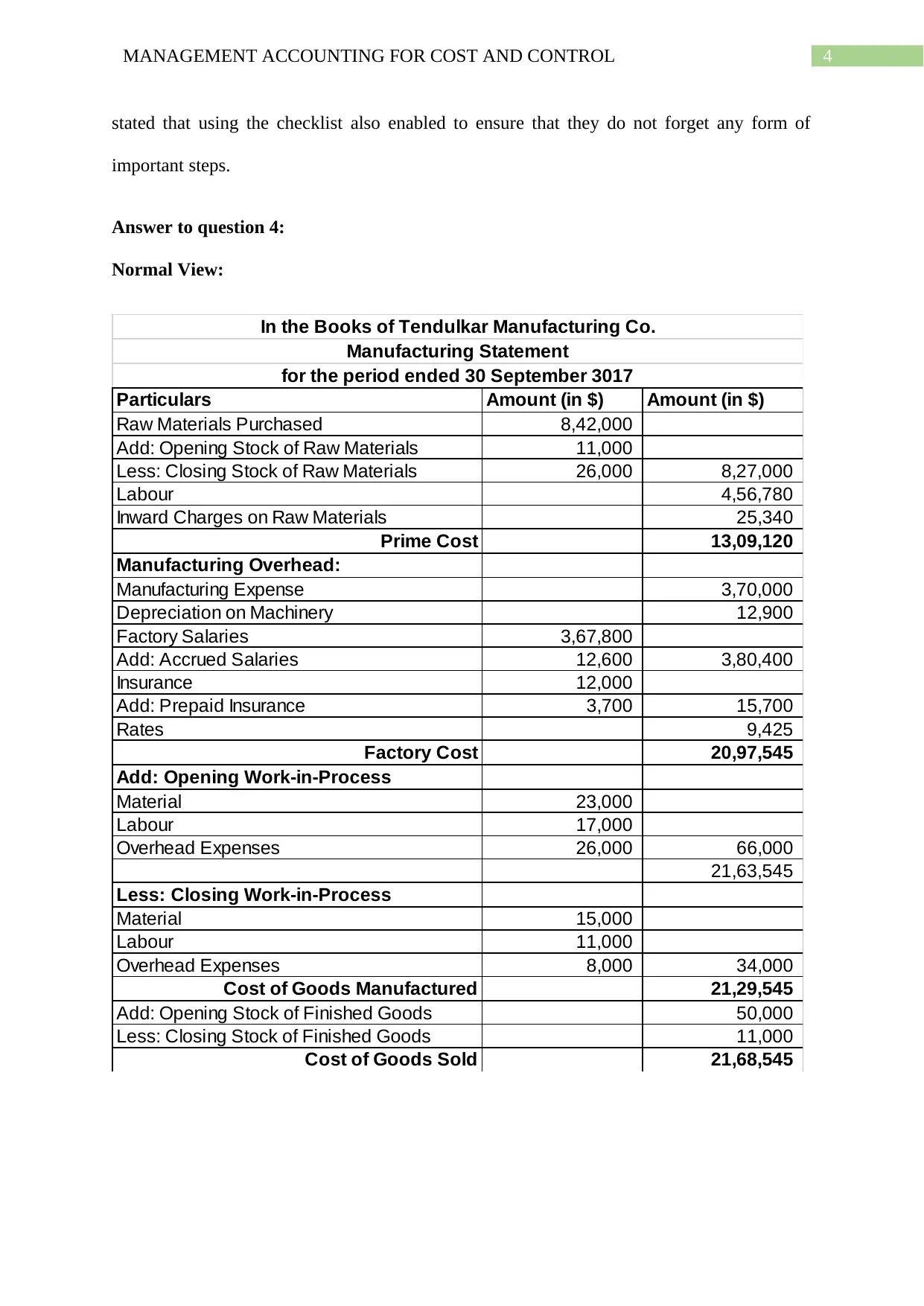
4MANAGEMENT ACCOUNTING FOR COST AND CONTROL
stated that using the checklist also enabled to ensure that they do not forget any form of
important steps.
Answer to question 4:
Normal View:
Particulars Amount (in $) Amount (in $)
Raw Materials Purchased 8,42,000
Add: Opening Stock of Raw Materials 11,000
Less: Closing Stock of Raw Materials 26,000 8,27,000
Labour 4,56,780
Inward Charges on Raw Materials 25,340
Prime Cost 13,09,120
Manufacturing Overhead:
Manufacturing Expense 3,70,000
Depreciation on Machinery 12,900
Factory Salaries 3,67,800
Add: Accrued Salaries 12,600 3,80,400
Insurance 12,000
Add: Prepaid Insurance 3,700 15,700
Rates 9,425
Factory Cost 20,97,545
Add: Opening Work-in-Process
Material 23,000
Labour 17,000
Overhead Expenses 26,000 66,000
21,63,545
Less: Closing Work-in-Process
Material 15,000
Labour 11,000
Overhead Expenses 8,000 34,000
Cost of Goods Manufactured 21,29,545
Add: Opening Stock of Finished Goods 50,000
Less: Closing Stock of Finished Goods 11,000
Cost of Goods Sold 21,68,545
In the Books of Tendulkar Manufacturing Co.
Manufacturing Statement
for the period ended 30 September 3017
stated that using the checklist also enabled to ensure that they do not forget any form of
important steps.
Answer to question 4:
Normal View:
Particulars Amount (in $) Amount (in $)
Raw Materials Purchased 8,42,000
Add: Opening Stock of Raw Materials 11,000
Less: Closing Stock of Raw Materials 26,000 8,27,000
Labour 4,56,780
Inward Charges on Raw Materials 25,340
Prime Cost 13,09,120
Manufacturing Overhead:
Manufacturing Expense 3,70,000
Depreciation on Machinery 12,900
Factory Salaries 3,67,800
Add: Accrued Salaries 12,600 3,80,400
Insurance 12,000
Add: Prepaid Insurance 3,700 15,700
Rates 9,425
Factory Cost 20,97,545
Add: Opening Work-in-Process
Material 23,000
Labour 17,000
Overhead Expenses 26,000 66,000
21,63,545
Less: Closing Work-in-Process
Material 15,000
Labour 11,000
Overhead Expenses 8,000 34,000
Cost of Goods Manufactured 21,29,545
Add: Opening Stock of Finished Goods 50,000
Less: Closing Stock of Finished Goods 11,000
Cost of Goods Sold 21,68,545
In the Books of Tendulkar Manufacturing Co.
Manufacturing Statement
for the period ended 30 September 3017
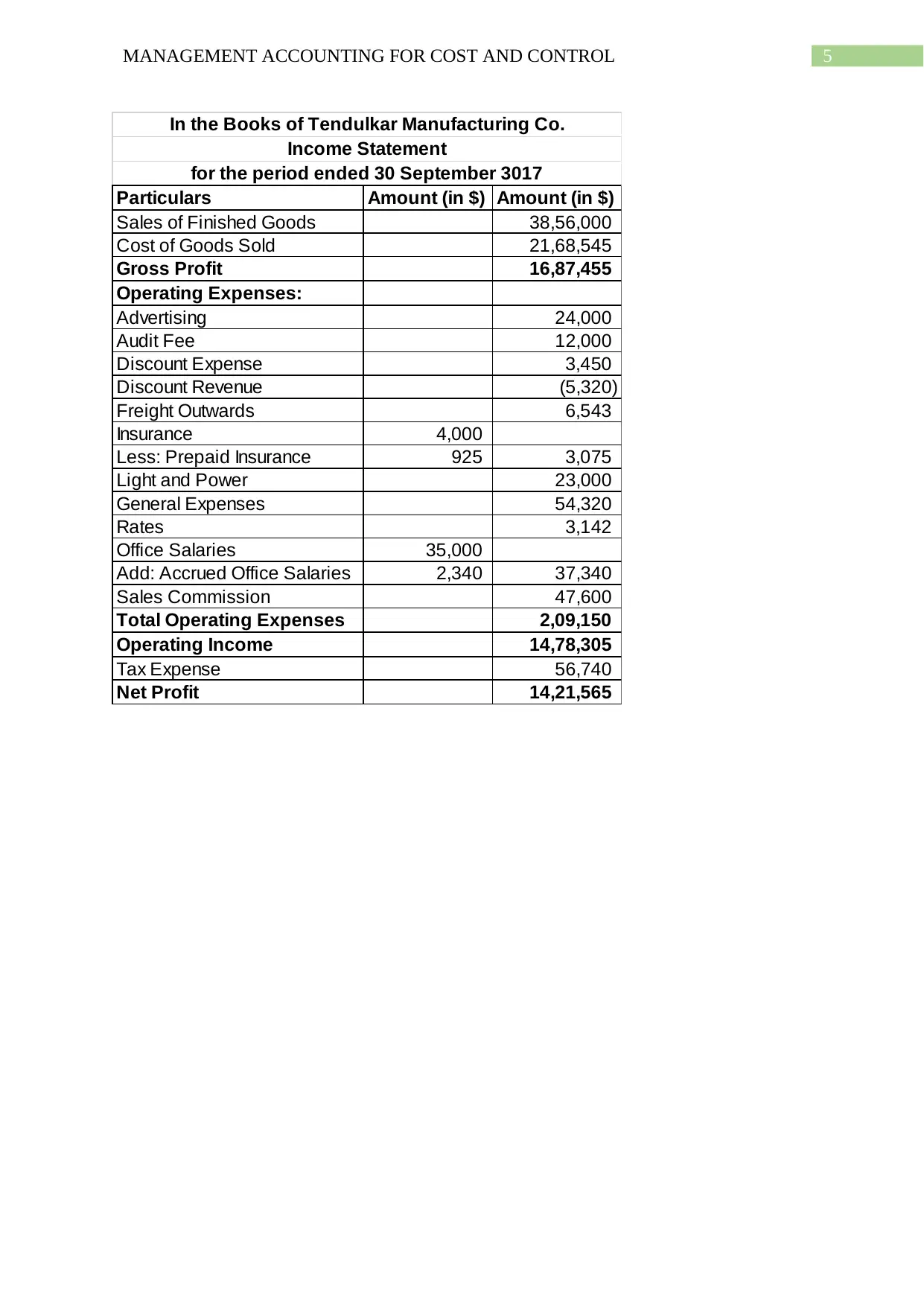
5MANAGEMENT ACCOUNTING FOR COST AND CONTROL
Particulars Amount (in $) Amount (in $)
Sales of Finished Goods 38,56,000
Cost of Goods Sold 21,68,545
Gross Profit 16,87,455
Operating Expenses:
Advertising 24,000
Audit Fee 12,000
Discount Expense 3,450
Discount Revenue (5,320)
Freight Outwards 6,543
Insurance 4,000
Less: Prepaid Insurance 925 3,075
Light and Power 23,000
General Expenses 54,320
Rates 3,142
Office Salaries 35,000
Add: Accrued Office Salaries 2,340 37,340
Sales Commission 47,600
Total Operating Expenses 2,09,150
Operating Income 14,78,305
Tax Expense 56,740
Net Profit 14,21,565
In the Books of Tendulkar Manufacturing Co.
Income Statement
for the period ended 30 September 3017
Particulars Amount (in $) Amount (in $)
Sales of Finished Goods 38,56,000
Cost of Goods Sold 21,68,545
Gross Profit 16,87,455
Operating Expenses:
Advertising 24,000
Audit Fee 12,000
Discount Expense 3,450
Discount Revenue (5,320)
Freight Outwards 6,543
Insurance 4,000
Less: Prepaid Insurance 925 3,075
Light and Power 23,000
General Expenses 54,320
Rates 3,142
Office Salaries 35,000
Add: Accrued Office Salaries 2,340 37,340
Sales Commission 47,600
Total Operating Expenses 2,09,150
Operating Income 14,78,305
Tax Expense 56,740
Net Profit 14,21,565
In the Books of Tendulkar Manufacturing Co.
Income Statement
for the period ended 30 September 3017
⊘ This is a preview!⊘
Do you want full access?
Subscribe today to unlock all pages.

Trusted by 1+ million students worldwide
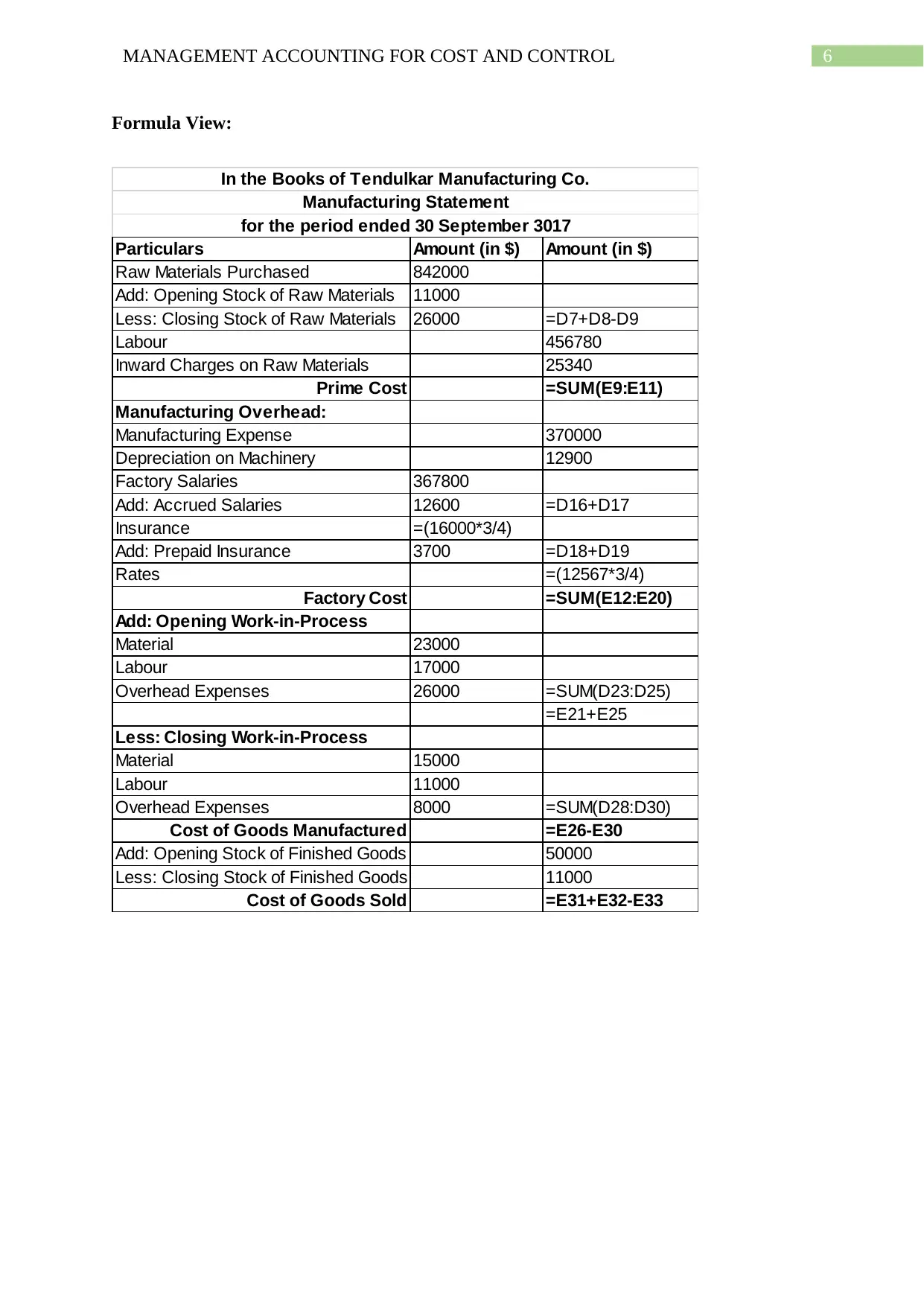
6MANAGEMENT ACCOUNTING FOR COST AND CONTROL
Formula View:
Particulars Amount (in $) Amount (in $)
Raw Materials Purchased 842000
Add: Opening Stock of Raw Materials 11000
Less: Closing Stock of Raw Materials 26000 =D7+D8-D9
Labour 456780
Inward Charges on Raw Materials 25340
Prime Cost =SUM(E9:E11)
Manufacturing Overhead:
Manufacturing Expense 370000
Depreciation on Machinery 12900
Factory Salaries 367800
Add: Accrued Salaries 12600 =D16+D17
Insurance =(16000*3/4)
Add: Prepaid Insurance 3700 =D18+D19
Rates =(12567*3/4)
Factory Cost =SUM(E12:E20)
Add: Opening Work-in-Process
Material 23000
Labour 17000
Overhead Expenses 26000 =SUM(D23:D25)
=E21+E25
Less: Closing Work-in-Process
Material 15000
Labour 11000
Overhead Expenses 8000 =SUM(D28:D30)
Cost of Goods Manufactured =E26-E30
Add: Opening Stock of Finished Goods 50000
Less: Closing Stock of Finished Goods 11000
Cost of Goods Sold =E31+E32-E33
In the Books of Tendulkar Manufacturing Co.
Manufacturing Statement
for the period ended 30 September 3017
Formula View:
Particulars Amount (in $) Amount (in $)
Raw Materials Purchased 842000
Add: Opening Stock of Raw Materials 11000
Less: Closing Stock of Raw Materials 26000 =D7+D8-D9
Labour 456780
Inward Charges on Raw Materials 25340
Prime Cost =SUM(E9:E11)
Manufacturing Overhead:
Manufacturing Expense 370000
Depreciation on Machinery 12900
Factory Salaries 367800
Add: Accrued Salaries 12600 =D16+D17
Insurance =(16000*3/4)
Add: Prepaid Insurance 3700 =D18+D19
Rates =(12567*3/4)
Factory Cost =SUM(E12:E20)
Add: Opening Work-in-Process
Material 23000
Labour 17000
Overhead Expenses 26000 =SUM(D23:D25)
=E21+E25
Less: Closing Work-in-Process
Material 15000
Labour 11000
Overhead Expenses 8000 =SUM(D28:D30)
Cost of Goods Manufactured =E26-E30
Add: Opening Stock of Finished Goods 50000
Less: Closing Stock of Finished Goods 11000
Cost of Goods Sold =E31+E32-E33
In the Books of Tendulkar Manufacturing Co.
Manufacturing Statement
for the period ended 30 September 3017
Paraphrase This Document
Need a fresh take? Get an instant paraphrase of this document with our AI Paraphraser
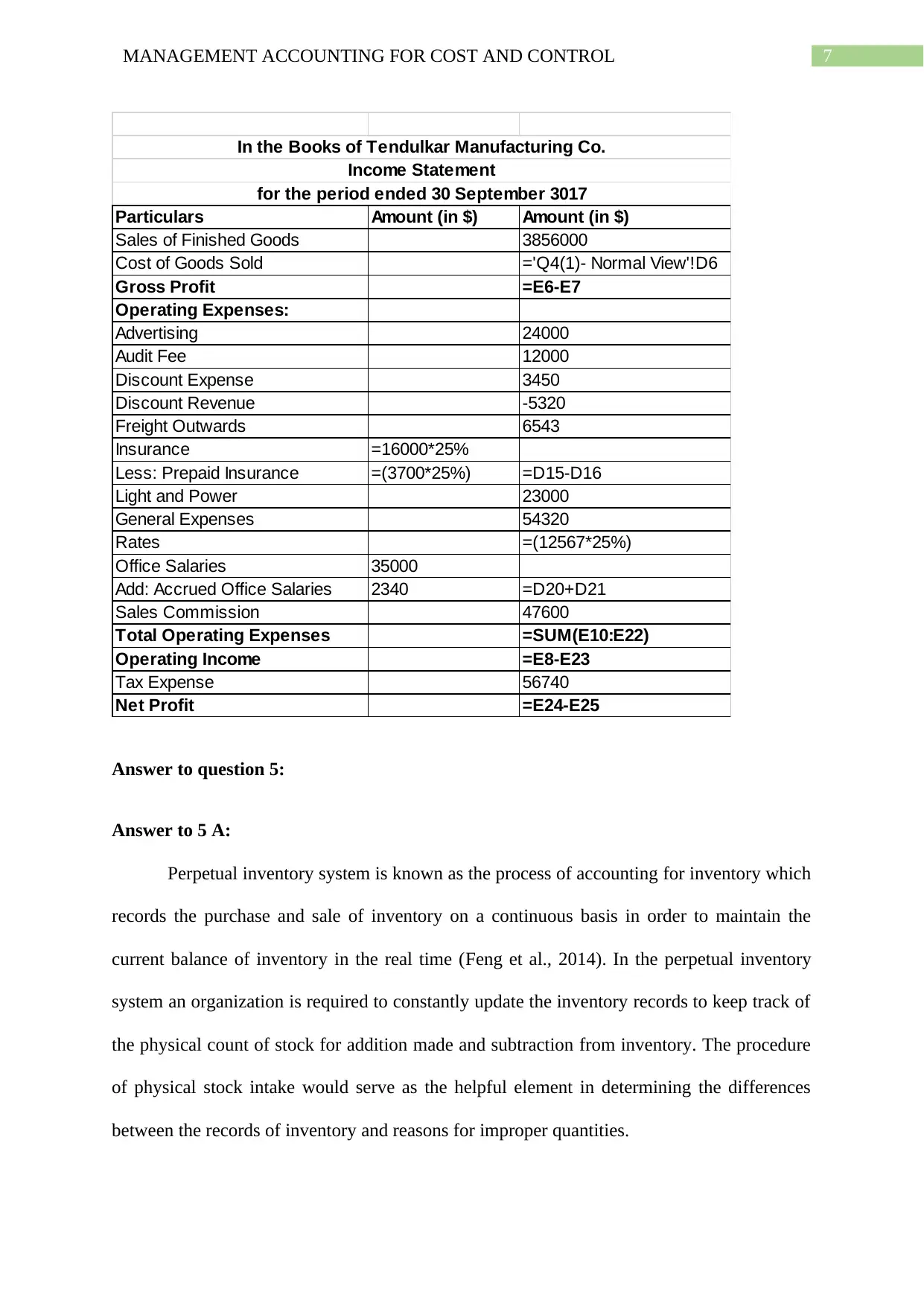
7MANAGEMENT ACCOUNTING FOR COST AND CONTROL
Particulars Amount (in $) Amount (in $)
Sales of Finished Goods 3856000
Cost of Goods Sold ='Q4(1)- Normal View'!D6
Gross Profit =E6-E7
Operating Expenses:
Advertising 24000
Audit Fee 12000
Discount Expense 3450
Discount Revenue -5320
Freight Outwards 6543
Insurance =16000*25%
Less: Prepaid Insurance =(3700*25%) =D15-D16
Light and Power 23000
General Expenses 54320
Rates =(12567*25%)
Office Salaries 35000
Add: Accrued Office Salaries 2340 =D20+D21
Sales Commission 47600
Total Operating Expenses =SUM(E10:E22)
Operating Income =E8-E23
Tax Expense 56740
Net Profit =E24-E25
In the Books of Tendulkar Manufacturing Co.
Income Statement
for the period ended 30 September 3017
Answer to question 5:
Answer to 5 A:
Perpetual inventory system is known as the process of accounting for inventory which
records the purchase and sale of inventory on a continuous basis in order to maintain the
current balance of inventory in the real time (Feng et al., 2014). In the perpetual inventory
system an organization is required to constantly update the inventory records to keep track of
the physical count of stock for addition made and subtraction from inventory. The procedure
of physical stock intake would serve as the helpful element in determining the differences
between the records of inventory and reasons for improper quantities.
Particulars Amount (in $) Amount (in $)
Sales of Finished Goods 3856000
Cost of Goods Sold ='Q4(1)- Normal View'!D6
Gross Profit =E6-E7
Operating Expenses:
Advertising 24000
Audit Fee 12000
Discount Expense 3450
Discount Revenue -5320
Freight Outwards 6543
Insurance =16000*25%
Less: Prepaid Insurance =(3700*25%) =D15-D16
Light and Power 23000
General Expenses 54320
Rates =(12567*25%)
Office Salaries 35000
Add: Accrued Office Salaries 2340 =D20+D21
Sales Commission 47600
Total Operating Expenses =SUM(E10:E22)
Operating Income =E8-E23
Tax Expense 56740
Net Profit =E24-E25
In the Books of Tendulkar Manufacturing Co.
Income Statement
for the period ended 30 September 3017
Answer to question 5:
Answer to 5 A:
Perpetual inventory system is known as the process of accounting for inventory which
records the purchase and sale of inventory on a continuous basis in order to maintain the
current balance of inventory in the real time (Feng et al., 2014). In the perpetual inventory
system an organization is required to constantly update the inventory records to keep track of
the physical count of stock for addition made and subtraction from inventory. The procedure
of physical stock intake would serve as the helpful element in determining the differences
between the records of inventory and reasons for improper quantities.
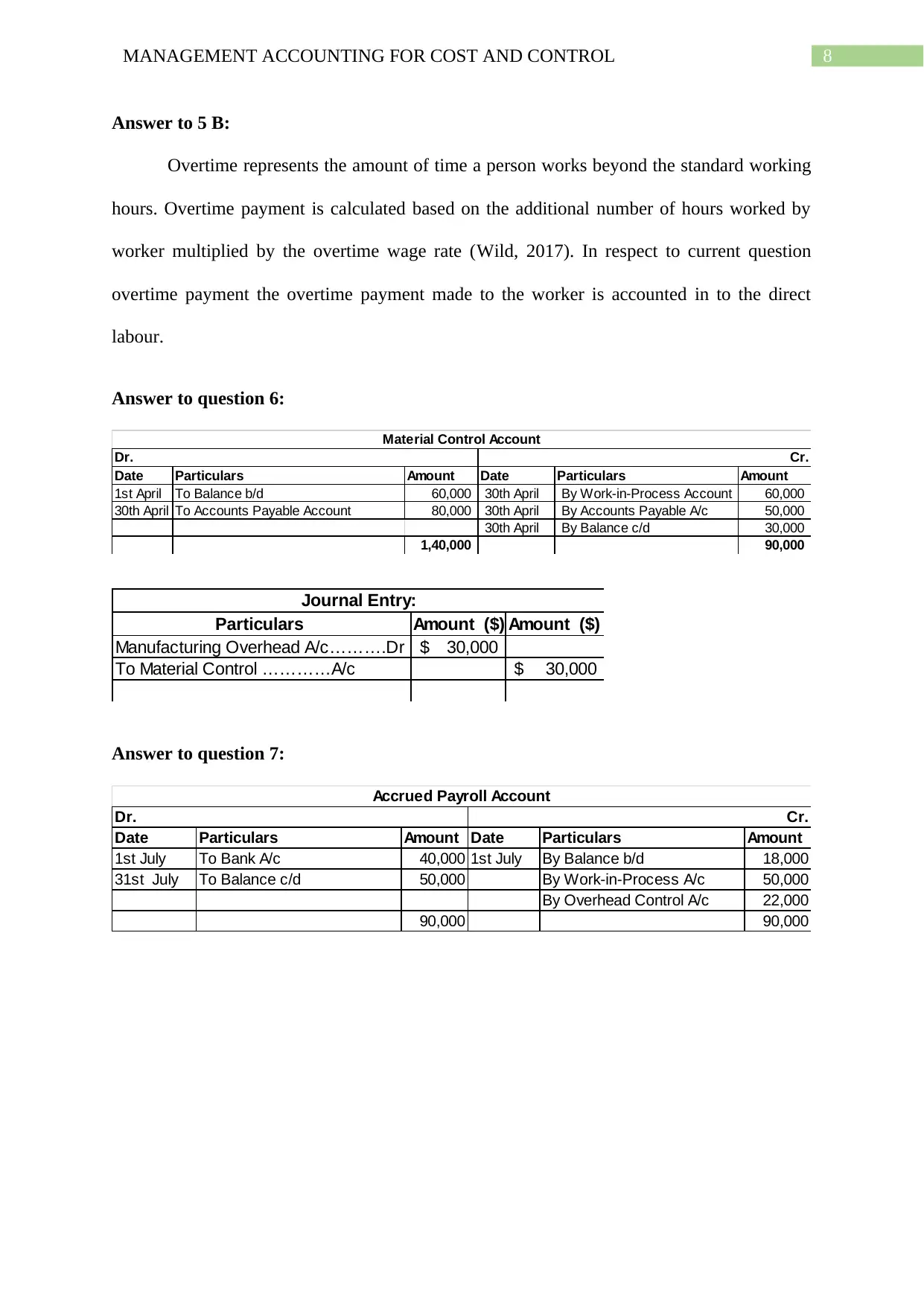
8MANAGEMENT ACCOUNTING FOR COST AND CONTROL
Answer to 5 B:
Overtime represents the amount of time a person works beyond the standard working
hours. Overtime payment is calculated based on the additional number of hours worked by
worker multiplied by the overtime wage rate (Wild, 2017). In respect to current question
overtime payment the overtime payment made to the worker is accounted in to the direct
labour.
Answer to question 6:
Date Particulars Amount Date Particulars Amount
1st April To Balance b/d 60,000 30th April By Work-in-Process Account 60,000
30th April To Accounts Payable Account 80,000 30th April By Accounts Payable A/c 50,000
30th April By Balance c/d 30,000
1,40,000 90,000
Material Control Account
Cr.Dr.
Particulars Amount ($) Amount ($)
Manufacturing Overhead A/c……….Dr 30,000$
To Material Control …………A/c 30,000$
Journal Entry:
Answer to question 7:
Date Particulars Amount Date Particulars Amount
1st July To Bank A/c 40,000 1st July By Balance b/d 18,000
31st July To Balance c/d 50,000 By Work-in-Process A/c 50,000
By Overhead Control A/c 22,000
90,000 90,000
Accrued Payroll Account
Dr. Cr.
Answer to 5 B:
Overtime represents the amount of time a person works beyond the standard working
hours. Overtime payment is calculated based on the additional number of hours worked by
worker multiplied by the overtime wage rate (Wild, 2017). In respect to current question
overtime payment the overtime payment made to the worker is accounted in to the direct
labour.
Answer to question 6:
Date Particulars Amount Date Particulars Amount
1st April To Balance b/d 60,000 30th April By Work-in-Process Account 60,000
30th April To Accounts Payable Account 80,000 30th April By Accounts Payable A/c 50,000
30th April By Balance c/d 30,000
1,40,000 90,000
Material Control Account
Cr.Dr.
Particulars Amount ($) Amount ($)
Manufacturing Overhead A/c……….Dr 30,000$
To Material Control …………A/c 30,000$
Journal Entry:
Answer to question 7:
Date Particulars Amount Date Particulars Amount
1st July To Bank A/c 40,000 1st July By Balance b/d 18,000
31st July To Balance c/d 50,000 By Work-in-Process A/c 50,000
By Overhead Control A/c 22,000
90,000 90,000
Accrued Payroll Account
Dr. Cr.
⊘ This is a preview!⊘
Do you want full access?
Subscribe today to unlock all pages.

Trusted by 1+ million students worldwide
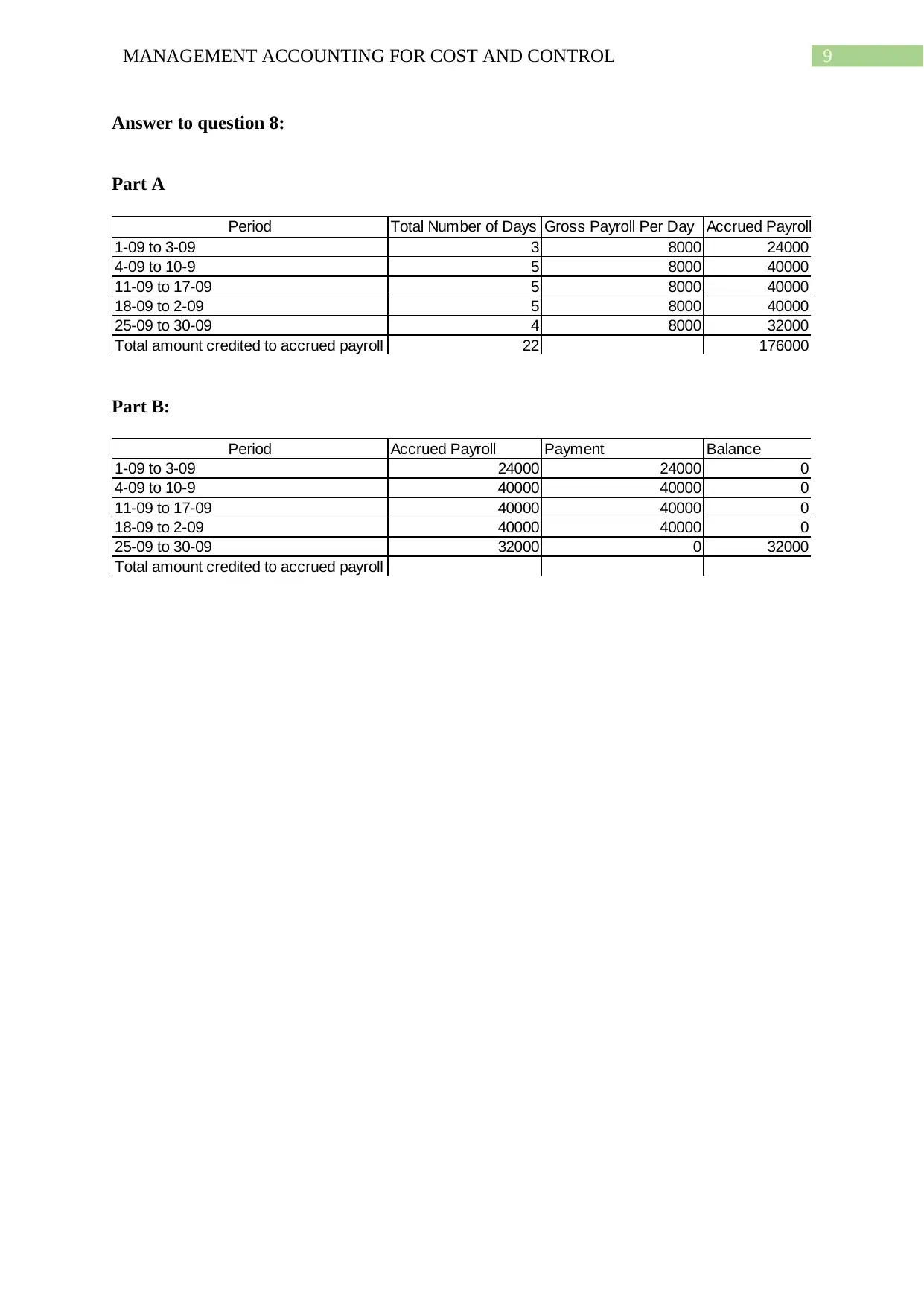
9MANAGEMENT ACCOUNTING FOR COST AND CONTROL
Answer to question 8:
Part A
Period Total Number of Days Gross Payroll Per Day Accrued Payroll
1-09 to 3-09 3 8000 24000
4-09 to 10-9 5 8000 40000
11-09 to 17-09 5 8000 40000
18-09 to 2-09 5 8000 40000
25-09 to 30-09 4 8000 32000
Total amount credited to accrued payroll 22 176000
Part B:
Period Accrued Payroll Payment Balance
1-09 to 3-09 24000 24000 0
4-09 to 10-9 40000 40000 0
11-09 to 17-09 40000 40000 0
18-09 to 2-09 40000 40000 0
25-09 to 30-09 32000 0 32000
Total amount credited to accrued payroll
Answer to question 8:
Part A
Period Total Number of Days Gross Payroll Per Day Accrued Payroll
1-09 to 3-09 3 8000 24000
4-09 to 10-9 5 8000 40000
11-09 to 17-09 5 8000 40000
18-09 to 2-09 5 8000 40000
25-09 to 30-09 4 8000 32000
Total amount credited to accrued payroll 22 176000
Part B:
Period Accrued Payroll Payment Balance
1-09 to 3-09 24000 24000 0
4-09 to 10-9 40000 40000 0
11-09 to 17-09 40000 40000 0
18-09 to 2-09 40000 40000 0
25-09 to 30-09 32000 0 32000
Total amount credited to accrued payroll
Paraphrase This Document
Need a fresh take? Get an instant paraphrase of this document with our AI Paraphraser
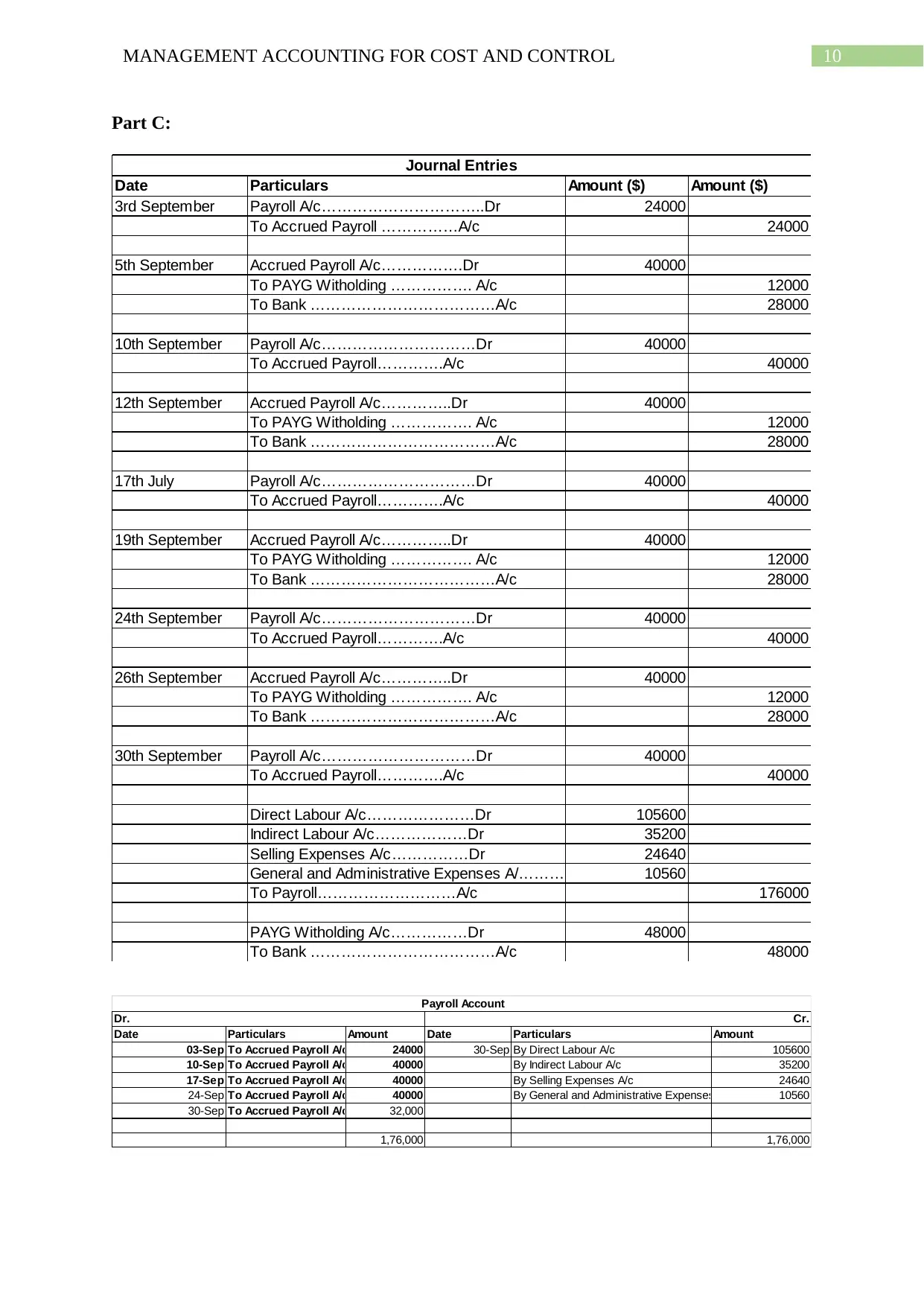
10MANAGEMENT ACCOUNTING FOR COST AND CONTROL
Part C:
Date Particulars Amount ($) Amount ($)
3rd September Payroll A/c…………………………..Dr 24000
To Accrued Payroll ……………A/c 24000
5th September Accrued Payroll A/c…………….Dr 40000
To PAYG Witholding ……………. A/c 12000
To Bank ………………………………A/c 28000
10th September Payroll A/c…………………………Dr 40000
To Accrued Payroll………….A/c 40000
12th September Accrued Payroll A/c…………..Dr 40000
To PAYG Witholding ……………. A/c 12000
To Bank ………………………………A/c 28000
17th July Payroll A/c…………………………Dr 40000
To Accrued Payroll………….A/c 40000
19th September Accrued Payroll A/c…………..Dr 40000
To PAYG Witholding ……………. A/c 12000
To Bank ………………………………A/c 28000
24th September Payroll A/c…………………………Dr 40000
To Accrued Payroll………….A/c 40000
26th September Accrued Payroll A/c…………..Dr 40000
To PAYG Witholding ……………. A/c 12000
To Bank ………………………………A/c 28000
30th September Payroll A/c…………………………Dr 40000
To Accrued Payroll………….A/c 40000
Direct Labour A/c…………………Dr 105600
Indirect Labour A/c………………Dr 35200
Selling Expenses A/c……………Dr 24640
General and Administrative Expenses A/………Dr 10560
To Payroll………………………A/c 176000
PAYG Witholding A/c……………Dr 48000
To Bank ………………………………A/c 48000
Journal Entries
Date Particulars Amount Date Particulars Amount
03-Sep To Accrued Payroll A/c 24000 30-Sep By Direct Labour A/c 105600
10-Sep To Accrued Payroll A/c 40000 By Indirect Labour A/c 35200
17-Sep To Accrued Payroll A/c 40000 By Selling Expenses A/c 24640
24-Sep To Accrued Payroll A/c 40000 By General and Administrative Expenses 10560
30-Sep To Accrued Payroll A/c 32,000
1,76,000 1,76,000
Payroll Account
Dr. Cr.
Part C:
Date Particulars Amount ($) Amount ($)
3rd September Payroll A/c…………………………..Dr 24000
To Accrued Payroll ……………A/c 24000
5th September Accrued Payroll A/c…………….Dr 40000
To PAYG Witholding ……………. A/c 12000
To Bank ………………………………A/c 28000
10th September Payroll A/c…………………………Dr 40000
To Accrued Payroll………….A/c 40000
12th September Accrued Payroll A/c…………..Dr 40000
To PAYG Witholding ……………. A/c 12000
To Bank ………………………………A/c 28000
17th July Payroll A/c…………………………Dr 40000
To Accrued Payroll………….A/c 40000
19th September Accrued Payroll A/c…………..Dr 40000
To PAYG Witholding ……………. A/c 12000
To Bank ………………………………A/c 28000
24th September Payroll A/c…………………………Dr 40000
To Accrued Payroll………….A/c 40000
26th September Accrued Payroll A/c…………..Dr 40000
To PAYG Witholding ……………. A/c 12000
To Bank ………………………………A/c 28000
30th September Payroll A/c…………………………Dr 40000
To Accrued Payroll………….A/c 40000
Direct Labour A/c…………………Dr 105600
Indirect Labour A/c………………Dr 35200
Selling Expenses A/c……………Dr 24640
General and Administrative Expenses A/………Dr 10560
To Payroll………………………A/c 176000
PAYG Witholding A/c……………Dr 48000
To Bank ………………………………A/c 48000
Journal Entries
Date Particulars Amount Date Particulars Amount
03-Sep To Accrued Payroll A/c 24000 30-Sep By Direct Labour A/c 105600
10-Sep To Accrued Payroll A/c 40000 By Indirect Labour A/c 35200
17-Sep To Accrued Payroll A/c 40000 By Selling Expenses A/c 24640
24-Sep To Accrued Payroll A/c 40000 By General and Administrative Expenses 10560
30-Sep To Accrued Payroll A/c 32,000
1,76,000 1,76,000
Payroll Account
Dr. Cr.
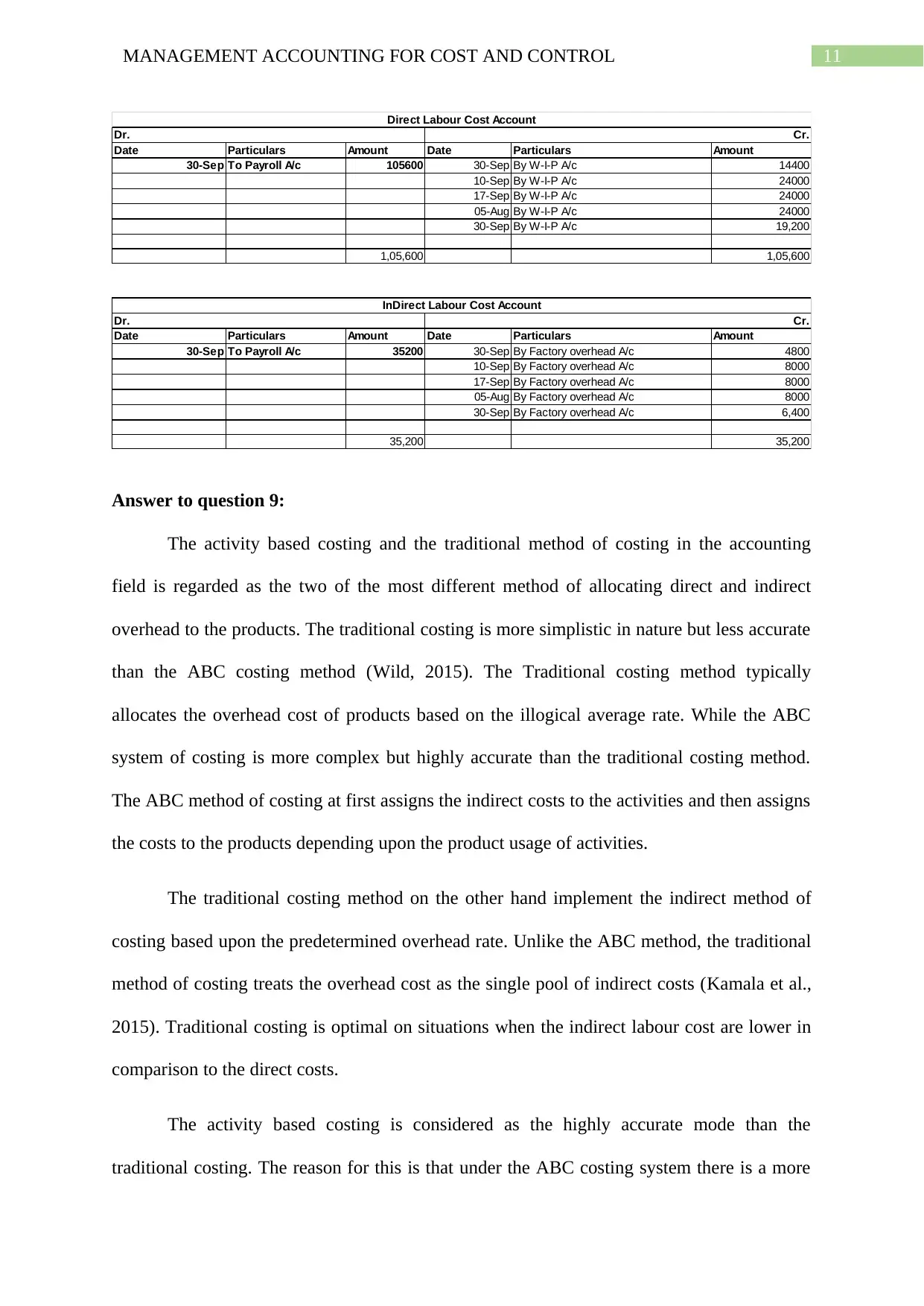
11MANAGEMENT ACCOUNTING FOR COST AND CONTROL
Date Particulars Amount Date Particulars Amount
30-Sep To Payroll A/c 105600 30-Sep By W-I-P A/c 14400
10-Sep By W-I-P A/c 24000
17-Sep By W-I-P A/c 24000
05-Aug By W-I-P A/c 24000
30-Sep By W-I-P A/c 19,200
1,05,600 1,05,600
Direct Labour Cost Account
Dr. Cr.
Date Particulars Amount Date Particulars Amount
30-Sep To Payroll A/c 35200 30-Sep By Factory overhead A/c 4800
10-Sep By Factory overhead A/c 8000
17-Sep By Factory overhead A/c 8000
05-Aug By Factory overhead A/c 8000
30-Sep By Factory overhead A/c 6,400
35,200 35,200
InDirect Labour Cost Account
Dr. Cr.
Answer to question 9:
The activity based costing and the traditional method of costing in the accounting
field is regarded as the two of the most different method of allocating direct and indirect
overhead to the products. The traditional costing is more simplistic in nature but less accurate
than the ABC costing method (Wild, 2015). The Traditional costing method typically
allocates the overhead cost of products based on the illogical average rate. While the ABC
system of costing is more complex but highly accurate than the traditional costing method.
The ABC method of costing at first assigns the indirect costs to the activities and then assigns
the costs to the products depending upon the product usage of activities.
The traditional costing method on the other hand implement the indirect method of
costing based upon the predetermined overhead rate. Unlike the ABC method, the traditional
method of costing treats the overhead cost as the single pool of indirect costs (Kamala et al.,
2015). Traditional costing is optimal on situations when the indirect labour cost are lower in
comparison to the direct costs.
The activity based costing is considered as the highly accurate mode than the
traditional costing. The reason for this is that under the ABC costing system there is a more
Date Particulars Amount Date Particulars Amount
30-Sep To Payroll A/c 105600 30-Sep By W-I-P A/c 14400
10-Sep By W-I-P A/c 24000
17-Sep By W-I-P A/c 24000
05-Aug By W-I-P A/c 24000
30-Sep By W-I-P A/c 19,200
1,05,600 1,05,600
Direct Labour Cost Account
Dr. Cr.
Date Particulars Amount Date Particulars Amount
30-Sep To Payroll A/c 35200 30-Sep By Factory overhead A/c 4800
10-Sep By Factory overhead A/c 8000
17-Sep By Factory overhead A/c 8000
05-Aug By Factory overhead A/c 8000
30-Sep By Factory overhead A/c 6,400
35,200 35,200
InDirect Labour Cost Account
Dr. Cr.
Answer to question 9:
The activity based costing and the traditional method of costing in the accounting
field is regarded as the two of the most different method of allocating direct and indirect
overhead to the products. The traditional costing is more simplistic in nature but less accurate
than the ABC costing method (Wild, 2015). The Traditional costing method typically
allocates the overhead cost of products based on the illogical average rate. While the ABC
system of costing is more complex but highly accurate than the traditional costing method.
The ABC method of costing at first assigns the indirect costs to the activities and then assigns
the costs to the products depending upon the product usage of activities.
The traditional costing method on the other hand implement the indirect method of
costing based upon the predetermined overhead rate. Unlike the ABC method, the traditional
method of costing treats the overhead cost as the single pool of indirect costs (Kamala et al.,
2015). Traditional costing is optimal on situations when the indirect labour cost are lower in
comparison to the direct costs.
The activity based costing is considered as the highly accurate mode than the
traditional costing. The reason for this is that under the ABC costing system there is a more
⊘ This is a preview!⊘
Do you want full access?
Subscribe today to unlock all pages.

Trusted by 1+ million students worldwide
1 out of 16
Related Documents
Your All-in-One AI-Powered Toolkit for Academic Success.
+13062052269
info@desklib.com
Available 24*7 on WhatsApp / Email
![[object Object]](/_next/static/media/star-bottom.7253800d.svg)
Unlock your academic potential
Copyright © 2020–2025 A2Z Services. All Rights Reserved. Developed and managed by ZUCOL.
